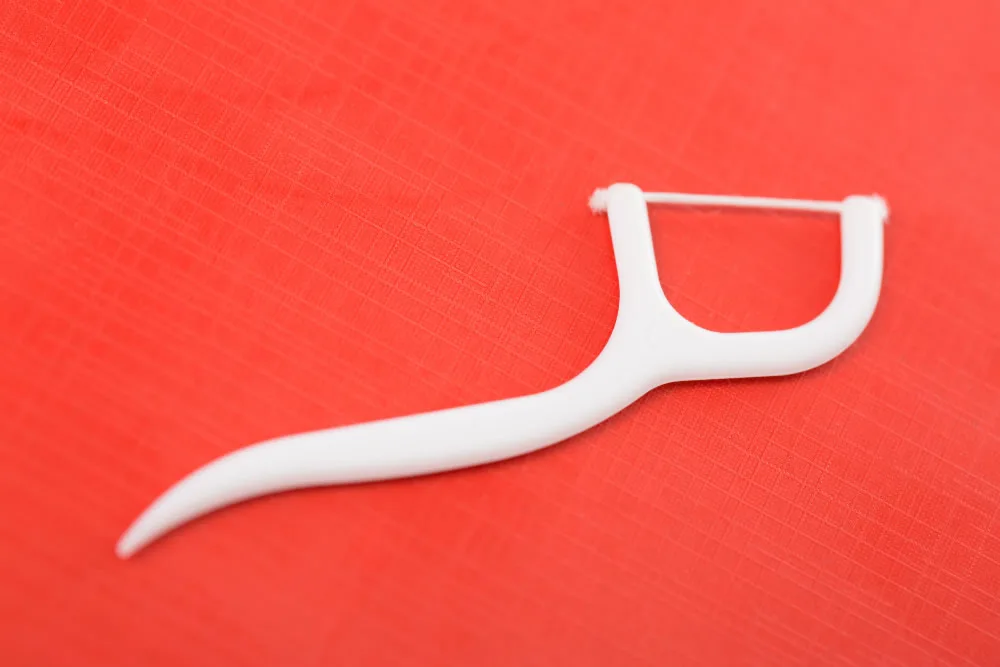
Dental floss is a medical material specifically designed to clean areas that toothbrushes cannot reach. Made from materials compatible with teeth and gums, it is particularly effective in cleaning tooth surfaces and interdental spaces. Modern dental floss has become much easier to use and is highlighted for preventing issues like bad breath in addition to maintaining oral hygiene.
Even using dental floss just once a day significantly contributes to oral hygiene. It should not be considered optional but rather an essential part of oral care for those striving to maintain healthy teeth and gums. While toothbrushes are crucial for oral hygiene, they often fail to remove food particles and plaque from hard-to-reach areas. This is where dental floss steps in, effectively removing debris and plaque from these regions.
Before addressing questions like whether it damages gums or can be reused, let’s explore the benefits it provides.
What Does Dental Floss Do?
Incorporating dental floss into your oral hygiene routine offers numerous benefits. Here are some of the key advantages:
Removes Plaque and Food Particles
Plaque and food particles often accumulate between teeth, potentially leading to cavities over time. Plaque buildup is also a primary cause of tartar formation. Brushing alone is insufficient to remove plaque and food particles from between teeth. Regular use of dental floss ensures these particles are effectively eliminated, even from the smallest spaces.
Protects Gum Health
While often considered beneficial solely for teeth, dental floss also plays a vital role in maintaining gum health. Plaque typically accumulates along the gum line, leading to infections if untreated. These infections can cause severe issues like receding gums, cavities, or even tooth loss. Thus, dental floss is crucial for gum health protection.
Prevents Cavities
Food particles trapped between teeth are often difficult to remove with brushing alone. Regular flossing ensures a thorough cleaning of these areas, reducing the risk of cavities.
Prevents Bad Breath
Bad breath isn’t always caused by cavities. Food debris left in the mouth can also contribute to unpleasant odors. Dental floss helps eliminate these trapped food particles in hard-to-reach areas, effectively preventing bad breath.
Prevents Periodontal Diseases
Regular flossing is highly effective in preventing periodontal diseases. Periodontitis, a severe gum condition, requires long and challenging treatments. Preventing such diseases begins with proper oral hygiene.
Supports Orthodontic Treatments
For individuals undergoing orthodontic treatment, maintaining oral hygiene is even more critical. Using dental floss daily helps these individuals protect their oral health, ensuring their treatment proceeds smoothly without complications such as gum or dental diseases.
Incorporating dental floss into your daily routine is a small step that yields significant long-term benefits for oral health.
How to Use Dental Floss?
One of the most critical aspects is using it correctly, as improper techniques can occasionally harm the gums or teeth. Here’s a step-by-step guide to ensure proper usage:
Prepare the Floss
Take about 30–45 cm of floss and wrap the ends around your middle fingers, leaving a small portion to work with. This working section is the part that will be used for cleaning your teeth.
Position the Floss
You can start with any tooth, but it’s common to begin with the back teeth. Curve the floss into a “C” shape around the tooth to clean both its surface and the area between the teeth.
Clean the Teeth
Gently glide the floss between the teeth, avoiding excessive pressure that could harm the gums. Use soft, up-and-down motions to clean the tooth surfaces.
Switch to a Clean Section
As you move to the next tooth, shift to a clean portion of the floss to ensure hygiene. You can slide the floss along your fingers to access a fresh section.
By following these steps, you can ensure effective cleaning while protecting your gums and teeth.
How to Choose Dental Floss?
Selecting the right type of dental floss depends on your oral structure and personal preferences:
PTFE Floss
These are the easiest to use and glide smoothly between teeth without fraying.
Nylon Floss
Available in various flavors, nylon floss offers a refreshing experience. However, it has a lower resistance to friction and a higher likelihood of breaking.
Floss Picks
For those who find traditional floss challenging to use, floss picks (with a built-in holder) are a convenient alternative.
If you’re unsure which type suits you best, consult your dentist for personalized recommendations.
Types of Dental Floss

Dental floss can be categorized by the materials used and its design:
By Material
- Nylon Floss: Affordable and flavored options but prone to breaking.
- PTFE Floss: Stronger, smoother, and less likely to fray.
By Design
- Traditional Roll Floss: Standard floss used manually.
- Floss Picks: Easier to use, especially for those with limited dexterity.
Each type offers unique advantages, so select one that best fits your needs and comfort level.
Which Type of Dental Floss Gives the Best Result?
The type of dental floss that gives the best result depends on the person’s dental structure. If the gaps between the teeth are very tight, filament dental floss types would be more appropriate as they are easier to insert between the teeth and slide more smoothly. However, if the gaps between the teeth are not very tight, other types can also provide successful results.
Can Dental Floss Be Used When Wearing Braces?
Yes, it can be used to clean the mouth even when wearing braces. However, individuals with braces need to be more careful to avoid damaging the brackets. If you are wearing braces, you should consult your dentist about the correct method for usage.
Can Dental Floss Help with Bad Breath?
There are many different reasons for bad breath in the mouth, one of which is the bacteria and plaque that accumulate on the teeth and between the teeth. If bad breath is caused by this, it can help reduce it by cleaning the teeth more effectively. However, if the cause of bad breath is tooth decay or gum disease, dental floss will not help, and medical treatment should be sought to address the underlying issue.
What Does Bleeding When Using Dental Floss Mean?
If bleeding occurs while using dental floss, it may indicate irritation of the gums. Additionally, it could be a sign of gum disease. It is essential to treat gum disease as early as possible, as neglecting it could lead to more severe conditions, such as periodontitis. If bleeding happens while cleaning your teeth with a brush or floss, you should consult your dentist.
Should I Use Dental Floss Up and Down or Side to Side?
First, take 35–40 cm of dental floss and clean the tooth surfaces by moving the floss up and down. It is better to clean in an up-and-down motion rather than side-to-side.
What Are Some Common Mistakes When Using Dental Floss?
Just like toothbrushes, dental floss needs to be used with the right technique. Some mistakes can lead to serious issues, and some of the most common mistakes include the following:
Not Washing Hands
Before using dental floss, hands must be washed thoroughly with antibacterial soap. Since hands come into contact with many different surfaces throughout the day, bacteria can accumulate, especially on fingertips. If the floss is used without washing hands, these bacteria will be transferred directly into the mouth, which can jeopardize oral health.
Improper Use
Using dental floss incorrectly can cause problems not only for your teeth but also for your gums. It is essential to learn and apply the correct techniques to avoid causing harm to your gum health.
Applying Too Much Force
You don’t need to apply excessive pressure to remove bacteria and plaque from the tooth surfaces. Applying too much force can harm both the gums and the teeth. A gentle pressure is enough for an effective cleaning.
Reusing Dental Floss
One of the biggest mistakes is reusing dental floss. Remember, it is designed for single use, and reusing it is harmful. Washing and reusing the floss will not properly clean it, and it will jeopardize your oral health.
Should I Brush My Teeth First or Use Dental Floss?
Dentists recommend using it first and then brushing your teeth. The reason for this is that it is more effective at removing plaque and debris between the teeth. After using floss, the bristles of the toothbrush can reach these areas more easily, providing a more thorough cleaning. However, if oral hygiene has been neglected for a long time, it may be a good idea to do a light brushing first, followed by the use of dental floss, and then brush the teeth again.
Can Dental Floss Be Reused?
No, it is a medical product designed for single use, and it should never be reused. The reason is that after use, bacteria and plaque can accumulate on the surface of the floss. Washing the floss does not remove these bacteria. Therefore, reusing them after washing it can jeopardize your oral health. Additionally, repeated use can cause wear and tear on the floss. If reused, the structural integrity of the floss is compromised, making it less effective for cleaning.
Can Dental Floss Be Used Every Day?
Yes, it is recommended to use them every day to clean both the surfaces of the teeth and between the teeth. Doing this once a day is sufficient to remove bacteria and plaque in the mouth. There is a common misconception that using them every day can damage the teeth, but this is not true. On the contrary, it is recommended to use them regularly to maintain proper oral hygiene.
Check it out –> Dental Implants Turkey
Can Dental Floss Damage the Gums?
No, when used correctly, it does not harm the teeth or gums. In fact, regular cleaning with them is necessary for maintaining good oral health. However, some mistakes in its use can potentially damage the gums. Some problems that may arise due to incorrect use of dental floss include:
Gum Irritation
If excessive pressure is applied while using them, it can cause irritation. The most obvious signs of gum irritation are redness and swelling of the gums. You may also experience mild gum bleeding. Therefore, it is crucial to avoid applying too much pressure on the gums when using dental floss.
Gum Bleeding
Gum bleeding can occur due to improper use of dental floss. The bleeding may be caused by irritation or infection. If you notice bleeding when you start using it, you should consult a dentist. This bleeding may be a sign of a different gum issue rather than a direct result of flossing.
Gum Injuries
Gum injuries can occur if excessive force is applied to the gums while using dental floss. Applying too much pressure on the gums can cause damage, so it is important to avoid this behavior.
Widening of the Contact Points Between Teeth
Using dental floss too frequently can be harmful, especially when excessive pressure is applied. This can lead to the widening of the contact points between the teeth, which may increase the risk of cavities.
For your information –> Dental Bridge
Should I Touch the Gums While Using Dental Floss?
No, there is no need to touch the gums with your fingers. It is important to clean the areas where the teeth meet the gums, as these are the places where bacteria and plaque tend to accumulate. Therefore, you should make sure to clean these areas thoroughly with dental floss. While touching the gums with your fingers is not harmful, it is not necessary to do so.
Feel free to ask any further questions you may have in the comments section.
It might interest you –> Antalya Dental Clinic
